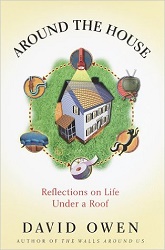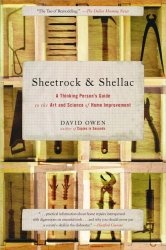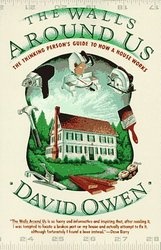A couple of weeks ago I mentioned some authors who had troubled adolescences but then went on to productive, happy lives. It didn’t seem appropriate to talk about them too much within the context of Sue Klebold’s book about her son, but I’ve thoroughly enjoyed reading these authors and picked up quite a bit of useful information from them. So they’ll appear over the course of the next few weeks.
I’m starting out with David Owen, who probably isn’t a household word but who should be. He’s primarily a magazine writer, but he’s also produced a number of books. His energy and enthusiasm are contagious, and he’s very funny. (I’ll be writing about his wife, Ann Hodgman, in a future post.) His interests are varied, including golf, parenthood, and the history of the Xerox corporation. But the ones I love and have learned from the most (I didn’t read any of the golf books) are about how our houses actually work. You’ll learn all about paint, and drywall, and concrete, and roofs, and plumbing . . . just about anything you can possibly imagine that helps comprise a house. Along the way Owen tells very funny stories about his own experiences as a homeowner, home remodeler, home repairer, and home builder. (Sheetrock and Shellac tells the story of how he built a vacation cabin just down the road from his regular house.) I will have to admit that Gideon found the section on concrete very boring—I was reading it aloud in the car on one of our trips—but I thought it was really interesting. (One nugget of wisdom: If you’re sitting at a red light, and you see a cement truck barreling down on you, get out of the way if at all possible.)
Owen’s adventures in home ownership came about because he and his wife had decided that they needed to move out of New York City when they had their first child. They had no car, as they didn’t need one in the city, so they rented one and went to look at some places in surrounding towns. Here was this 200-year-old house that had been moved to its current location in two pieces, and the re-join hadn’t been entirely successful, so there was a two-inch difference in floor level between them. At one point the house had been used as a boys’ school, so there was a huge communal bathroom. On and on. But hey, it was late at night, it was raining, and as Owen says, “What were we going to do if we didn’t buy this house? Rent another car?” So they bought it. What ensues is often very funny, but it’s not The Money Pit or George Washington Slept Here. Those are pieces of fiction created for laughs. Owen’s books are telling the very endearing truth. (So he admits that their Christmas picture, taken in the dining room two years after their move, shows the walls as bare gray sheetrock with white seams and dabs from the mudding process.) I love the fact that the family has people over all through the renovation process; Owen says that he’d often find people at parties standing in the laundry room, elbows planted on piles of towels or underwear, carrying on animated conversations. (When we moved into our much-less-in-need-of-renovation house, I said, “We can’t say that we’ll wait until the house is finished before we have people over, or we’ll never do it. We’ll just have to plunge in.” And so we did. I think our first company dinner took place in the midst of boxes while there was still protective paper taped to the hardwood floors and bare plywood where we’d ripped up the carpet.)
You’ll learn a ton about home maintenance and repair in a very painless way with these books. One review on Amazon of TWAU says, “This is a fine entry in the category of Well-written, Wryly-humorous Books About the Trials of Ordinary Life That Also Contain a Surprising Amount of Useful Information.” Do you need to strip off the old paint on the outside of your house before you re-paint it, or choose what you’re going to use for your new roof, or figure out why your toilet is leaking? All addressed. You won’t feel incompetent, as many do-it-yourself books or programs can make you feel (You should be able to do this! It’s so easy!), or, on the other hand, superior (These people don’t know what they’re doing!). You’ll just nod in recognition and (probably) be inspired to get going on your own projects.
One priceless insight: When you take on a project that you’ve never tackled before, you don’t know what you’re doing. So you learn as you go, making mistakes and (mostly) correcting them. When you’re all done, you’ve learned how to do it. But now it’s too late for you to apply what you’ve learned, since the project is now over. Unless you’re going to turn right around and re-do it, or unless you’re going to go into business doing it for other people, all that experience does you no good. We’ve seen this process play out in just about every job we’ve done in the houses we’ve owned. (My brother built his own house, and he says he did the job twice: first the cheap way, then the right way.)
Well, I guess I’ll quit this post for now so that you can stop reading what I’m saying about David Owen and start reading him for yourself. Sheetrock and Shellac is available on Kindle, but the other two only exist as real paper-and-ink books. You may be able to find them at your local library. In any case, he’s worth hunting down. Click on the book image to go to the Amazon page that has it for sale, and visit his blog. He’s more interested these days in writing about sustainability than sheetrock, it seems.


